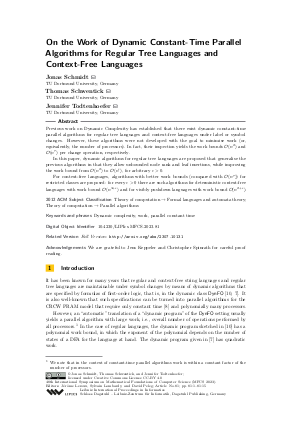On the Work of Dynamic Constant-Time Parallel Algorithms for Regular Tree Languages and Context-Free Languages
Authors Jonas Schmidt, Thomas Schwentick, Jennifer Todtenhoefer
-
Part of:
Volume:
48th International Symposium on Mathematical Foundations of Computer Science (MFCS 2023)
Part of: Series: Leibniz International Proceedings in Informatics (LIPIcs)
Part of: Conference: Mathematical Foundations of Computer Science (MFCS) - License:
 Creative Commons Attribution 4.0 International license
Creative Commons Attribution 4.0 International license
- Publication Date: 2023-08-21
File

PDF
LIPIcs.MFCS.2023.81.pdf
- Filesize: 0.86 MB
- 15 pages
Document Identifiers
Related Versions
- Full Version http://arxiv.org/abs/2307.10131
Subject Classification
ACM Subject Classification
- Theory of computation → Formal languages and automata theory
- Theory of computation → Parallel algorithms
Keywords
- Dynamic complexity
- work
- parallel constant time
Metrics
- Access Statistics
-
Total Accesses (updated on a weekly basis)
0PDF Downloads0Metadata Views
Abstract
Previous work on Dynamic Complexity has established that there exist dynamic constant-time parallel algorithms for regular tree languages and context-free languages under label or symbol changes. However, these algorithms were not developed with the goal to minimise work (or, equivalently, the number of processors). In fact, their inspection yields the work bounds 𝒪(n²) and 𝒪(n⁷) per change operation, respectively.
In this paper, dynamic algorithms for regular tree languages are proposed that generalise the previous algorithms in that they allow unbounded node rank and leaf insertions, while improving the work bound from 𝒪(n²) to 𝒪(n^ε), for arbitrary ε > 0.
For context-free languages, algorithms with better work bounds (compared with 𝒪(n⁷)) for restricted classes are proposed: for every ε > 0 there are such algorithms for deterministic context-free languages with work bound 𝒪(n^{3+ε}) and for visibly pushdown languages with work bound 𝒪(n^{2+ε}).
Cite As Get BibTex
Jonas Schmidt, Thomas Schwentick, and Jennifer Todtenhoefer. On the Work of Dynamic Constant-Time Parallel Algorithms for Regular Tree Languages and Context-Free Languages. In 48th International Symposium on Mathematical Foundations of Computer Science (MFCS 2023). Leibniz International Proceedings in Informatics (LIPIcs), Volume 272, pp. 81:1-81:15, Schloss Dagstuhl – Leibniz-Zentrum für Informatik (2023)
https://doi.org/10.4230/LIPIcs.MFCS.2023.81
BibTex
@InProceedings{schmidt_et_al:LIPIcs.MFCS.2023.81,
author = {Schmidt, Jonas and Schwentick, Thomas and Todtenhoefer, Jennifer},
title = {{On the Work of Dynamic Constant-Time Parallel Algorithms for Regular Tree Languages and Context-Free Languages}},
booktitle = {48th International Symposium on Mathematical Foundations of Computer Science (MFCS 2023)},
pages = {81:1--81:15},
series = {Leibniz International Proceedings in Informatics (LIPIcs)},
ISBN = {978-3-95977-292-1},
ISSN = {1868-8969},
year = {2023},
volume = {272},
editor = {Leroux, J\'{e}r\^{o}me and Lombardy, Sylvain and Peleg, David},
publisher = {Schloss Dagstuhl -- Leibniz-Zentrum f{\"u}r Informatik},
address = {Dagstuhl, Germany},
URL = {https://drops.dagstuhl.de/entities/document/10.4230/LIPIcs.MFCS.2023.81},
URN = {urn:nbn:de:0030-drops-186152},
doi = {10.4230/LIPIcs.MFCS.2023.81},
annote = {Keywords: Dynamic complexity, work, parallel constant time}
}
Author Details
Acknowledgements
We are grateful to Jens Keppeler and Christopher Spinrath for careful proof reading.
References
-
Amir Abboud, Arturs Backurs, and Virginia Vassilevska Williams. If the current clique algorithms are optimal, so is valiant’s parser. SIAM J. Comput., 47(6):2527-2555, 2018.

- Rajeev Alur and P. Madhusudan. Visibly pushdown languages. In László Babai, editor, Proceedings of the 36th Annual ACM Symposium on Theory of Computing (STOC), pages 202-211, 2004. URL: https://doi.org/10.1145/1007352.1007390.
- Antoine Amarilli, Pierre Bourhis, and Stefan Mengel. Enumeration on trees under relabelings. In Benny Kimelfeld and Yael Amsterdamer, editors, 21st International Conference on Database Theory (ICDT), volume 98 of LIPIcs, pages 5:1-5:18. Schloss Dagstuhl - Leibniz-Zentrum für Informatik, 2018. URL: https://doi.org/10.4230/LIPIcs.ICDT.2018.5.
- Mikołaj Bojańczyk. Algorithms for regular languages that use algebra. SIGMOD Rec., 41(2):5-14, 2012. URL: https://doi.org/10.1145/2350036.2350038.
-
Hubert Comon, Max Dauchet, Rémi Gilleron, Florent Jacquemard, Denis Lugiez, Christof Löding, Sophie Tison, and Marc Tommasi. Tree Automata Techniques and Applications. hal-03367725, 2008.

- Gudmund Skovbjerg Frandsen, Peter Bro Miltersen, and Sven Skyum. Dynamic word problems. J. ACM, 44(2):257-271, 1997. URL: https://doi.org/10.1145/256303.256309.
- Wouter Gelade, Marcel Marquardt, and Thomas Schwentick. The dynamic complexity of formal languages. ACM Trans. Comput. Log., 13(3):19, 2012. URL: https://doi.org/10.1145/2287718.2287719.
-
Neil Immerman. Descriptive complexity. Springer Science & Business Media, 2012.

-
Joseph F. JáJá. An Introduction to Parallel Algorithms. Addison-Wesley, 1992.

- Sushant Patnaik and Neil Immerman. Dyn-FO: A Parallel, Dynamic Complexity Class. J. Comput. Syst. Sci., 55(2):199-209, 1997. URL: https://doi.org/10.1006/jcss.1997.1520.
- Jonas Schmidt, Thomas Schwentick, Till Tantau, Nils Vortmeier, and Thomas Zeume. Work-sensitive dynamic complexity of formal languages. In Stefan Kiefer and Christine Tasson, editors, Foundations of Software Science and Computation Structures - 24th International Conference (FOSSACS), pages 490-509, 2021. URL: https://doi.org/10.1007/978-3-030-71995-1_25.
- Felix Tschirbs, Nils Vortmeier, and Thomas Zeume. Dynamic complexity of regular languages: Big changes, small work. In Bartek Klin and Elaine Pimentel, editors, 31st EACSL Annual Conference on Computer Science Logic (CSL), pages 35:1-35:19, 2023. URL: https://doi.org/10.4230/LIPIcs.CSL.2023.35.
-
Peter van Emde Boas. Machine models and simulation. In Jan van Leeuwen, editor, Handbook of Theoretical Computer Science, Volume A: Algorithms and Complexity, pages 1-66. Elsevier and MIT Press, 1990.

- Virginia Vassilevska Williams. Multiplying matrices faster than Coppersmith-Winograd. In Howard J. Karloff and Toniann Pitassi, editors, Proceedings of the 44th Symposium on Theory of Computing Conference (STOC), pages 887-898, 2012. URL: https://doi.org/10.1145/2213977.2214056.
